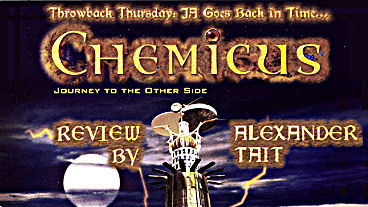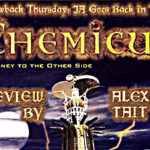
Throwback Thursday: Chemicus







Note: Review originally posted December 1, 2002
Thanks to Randy, I got to review the follow-up to Bioscopia, Chemicus. For this reason, I have structured my review exactly the same as the Bioscopia one. As always, Tivola and Heureka release these edutainment titles, based on a category of science, in their native Germany prior to releasing them to the rest of the world.Chemicus is based on chemistry (while Bioscopia and Physicus were based on biology and physics, respectively), which was not my favorite or strongest subject in school. However, chemistry was always the most interesting of the three subjects. Why? Imagine mad scientists mixing elixirs in the futile search for new life. Picture explosions as two volatile substances react while the teacher runs around in a senseless flap. AND sometimes you got to use the Bunsen burner and burn things! No secret as to why I didn’t achieve my full potential in Chemistry!
STORY
Adventure quiz: I’m thinking of a first-person game set in a fantasy world. There is little background story as to why you are there. Graphics are of a slide show type except for occasional QuickTime videos. There is no interaction with other characters, yet sentient creatures obviously lived here at some time. Storyline is revealed through scattered journals. Any takers? If you answered “Chemicus” then you win the three nights all-expenses-paid cruise to Omaha. Any other answer is incorrect. This game follows the structure of the previous games and is heavily based on that well-known “M” game. However, compared to Bioscopia, the video sequences are far crisper and a delight to view. The background scenes are typically excellent and even feature some movement. I was intrigued just like I was with all those other games based on the ancestor of first-person point and click adventure games. The chemistry slant intrigued me, so despite the shallow story, I never felt bored. For this reason, I award this game’s story a B.
LOGIC
In the overall scheme of things, these puzzles have little logical progression. It is not clear why these tasks must be completed. Each solved puzzle only really allows entry to another area and access to more puzzles. However, the relevance of the tasks to chemistry must be considered. Every puzzle relates to a fundamental principle of chemistry, and as such, has logical merit. Examination of the built-in database reveals the basis for inclusion of the puzzles. Obviously, this is an edutainment game, so incorporation of the puzzles into the story comes second to ensuring that lessons can be learned. For this reason, the game is yet another contender for mandatory school software rather than mandatory adventure game. In future titles, it would be good to see Tivola explore embracing an overall logic through a developed storyline similar to Byzantine the Betrayal, an excellent example of adventure game and edutainment title. For this game, the logic value rates a B-.
GRAPHICS
This title follows a similar graphical style to both Physicus and Bioscopia, with little enhancements from the previous games. One area this game really shines in is in the movie department. The game uses QuickTime 5 and they have striven to make the videos far better than those in the previous games. The backgrounds are clear, beautiful, and often feature animated components that greatly enhance the immersion. Have a look at the screenshots and I’m sure you’ll agree this game really is worthy of a look. The graphics are, of course, not 3D and do not make use of any lighting or new-fangled inventions. Nor does the game need it. Play Gabriel Knight 3 and then this game and you can see what the opponents of 3D adventure games are all about. On the downside, the graphics aren’t full screen so about half of the screen is made up of interface. Despite this, the game thoroughly deserves an A for its graphics.
SOUND
Little change here from the previous game except for the addition of a couple of voice actors who are above average but not Shakespearean in stature. Ambient noise is the primary sound featured in the game and is adequate to set the scene. The absence of music makes for a more immersive experience as the player is led into a world of first-person experience rather than just watching a movie. Hearing-impaired players will (continue to) be disappointed by the absence of subtitles. Fortunately, there are few spoken sections and as noted above, the story is wispy at best and no puzzle was affected by the game not having subtitles. Sound deserves a B.
GAMEPLAY
As with previous titles in this series, the game is first-person point-and-click. The interface is very straightforward, with save and load features, inventory, and information database all available from around the edges of the screen. The minor problems with the smart cursor have been rectified and I had no trouble with distinguishing “down”, “turn around”, or “go back”. The only area that could have been clearer was the actual name of the saving feature. The game calls it “score” though there is no sign of a score anywhere! Once you access the score section, it is quite easy to save, load, and exit. It has a nice safety feature that checks if you want to save your game before exiting. For anyone stuck in the game, and useful for schools that need solutions to more difficult puzzles, there is a walkthrough on the disk in Adobe Acrobat format which features pictures. I’m sure most people will be glancing at this document at least once during the game. The game gets a well deserved A for gameplay.
EDUTAINMENT VALUE
I found this game harder than Bioscopia and got stuck far more often with this game. I enjoyed the experiment-type puzzles but found my enjoyment was tinged with an annoyance that reduced my enjoyment. I felt that the educational parts overshadowed the adventure components (i.e. the fun part). Although things have not changed a great deal from the previous game, the feeling of the game being “less fun” made me wonder whether this would have as much success in a chemistry class as the other titles. This is a relatively minor quibble but one I think Tivola could address to produce a truly excellent adventure and educational title. Overall, though, the edutainment level is on par with a B.
GAME ISSUES
Strangely, this game has lower system specifications than does Bioscopia, but only marginally so. I played this on an Athlon 600 (using a 64 MB 3Dforce MX 400) under Windows 98SE and experienced near perfection in execution. The only problems I noted were a couple of places where there were graphical slow downs, such as a moving lava pit. This game installed without any problems. As with the previous game, it is quite stable. The videos continue to stream from the disk (which I hate because of the jerkiness that happens due to the slower rate of the CD-ROM). I hope Tivola and company eventually decide to provide the option of placing the videos in the game directory in future games. For these very minor irritations, I believe this game deserves an A- in this area.
OVERALL
As I’ve said before, the fun went on a short vacation in this game. It was not a chore to play but it didn’t reach the full potential set by its predecessors. Graphically, the game is excellent but the game itself is weighed down by an overly strong commitment to demonstrating fundamentals of chemistry at the expense of adventure and story elements. Who will enjoy this game? People who don’t need character interaction or a well-developed story and are content puzzling through brainteasers that will not likely be found in any other games. Novice adventurers will probably find this too hard-going but more experienced gamers may like to explore flexing their brain muscles… This game deserves a B overall and I look forward to their next title, which I hope will return to earlier subtly better form.
Final Grade: B
System Requirements:
WIN
- WIN 95/98/NT/ME/200/XP
- Pentium II, 233 MHz
- 64 MB RAM
- 50 MB free hard disk space
- SVGA graphics card (32 bit)
- sound card
- CD-ROM drive 8x speed
- Quicktime 5 (included)
MAC
- OS 8.1 or higher
- 233 MHz Power PC
- G3
- 64 MB RAM
- 50 MB free hard disk space
- 32.768 color graphics card
- sound card
- CD-ROM drive 8x speed
- Quicktime 5 (included)

Leave a Reply